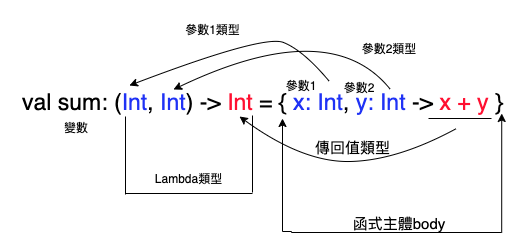Lambda
Prerequisites:
Lambda就是匿名函式,沒有名字的函式。
Lambda是變數類型
Lambda的類型是由「傳入的參數」與「傳回值類型」所決定的。
此處的Lambda與C++的函式指標有相同的概念。
有名字的函式
有名字的函式要用return傳回值。
fun 函式名(參數): 傳回值類型 {
return 傳回值
}
1
2
3
fun sum(a: Int, b: Int): Int {
return a + b
}
沒有名字的函式Lambda
用花括號{}開始跟結束,使用->將參數跟函式內容分開,參數可以1個、多個、或沒有。
函式內容可以有多行,最後計算的運算式作為Lambda傳回值,例如下面程式碼傳回x + 5的結果。
->用於分隔任何參數。
->後面要傳回的結果,Lambda不用有return。
如果Lambda沒有參數,可以省略->
Lambda
1
{ x: Int -> "The value is $x" }
把Lambda指派給變數,並執行。
1
2
3
val msg = { x: Int -> "The value is $x" }
// 執行Lambda有代入參數,要用${運算式}
println("pass 6 to msg:${msg(6)}")
pass 6 to msg:The value is 6
Lambda類型
變數的類型是Lambda,Lambda類型是「傳入的參數類型與個數」+「傳回值類型」所組合。
Lambda可以指派給變數,以下把{ x: Int, y: Int -> x + y }指派給變數sum。

{}大括號是函式主體body,函式主體中有「參數」與「傳回值」,與Lambda類型是一致的。
1
2
3
// 變數: (傳入的參數類型) -> 傳回值類型 = {參數: 類型, 參數: 類型 -> 傳回值}
val sum: (Int, Int) -> Int = { x: Int, y: Int -> x + y }
println(sum(10, 20));
30
自動推導Lambda類型
變數的Lambda類型是可以自動推導的,就可以省略Lambda類型。
1
2
3
4
// 省略Lambda類型(Int, Int) -> Int
val sum = { x: Int, y: Int -> x + y }
// 有帶參數記得加上花括號印出${}
println("sum = ${sum(15, 25)}");
sum = 40
sendMsg1的Lambda類型是可以自動推導,就可以省略Lambda類型。
1
2
3
4
5
6
// 省略Lambda類型() -> String
val sendMsg1 = {
val appendMsg = "nice to meet you."
"傳回訊息1 = $appendMsg"
}
println(sendMsg1())
傳回訊息1 = nice to meet you.
省略函式主體參數類型
如果Lambda類型沒有省略,{}大括號稱為函式主體body,函式主體中的參數「類型」是可以省略。
1
2
// 變數: (傳入的參數類型) -> 傳回值類型 = {參數, 參數 -> 傳回值}
val sum: (Int, Int) -> Int = { x, y -> x + y }
參數只有一個,使用it
參數只有一個。
1
2
3
// 變數: (傳入的參數類型) -> 傳回值類型 = {參數 -> 傳回值}
val sendMsg: (String) -> String = { msg -> "傳回訊息 = $msg" }
println(sendMsg("Hello world!"))
傳回訊息 = Hello world!
省略msg參數,省略->箭頭,把$msg變成$it,只針對「參數只有一個」。
1
2
val sendMsg: (String) -> String = { "傳回訊息 = $it" }
println(sendMsg("Hello world!"))
傳回訊息 = Hello world!
多行程式碼,最後一行是傳回值
在函式主體{}中,可以有多行程式碼,最後一行是傳回值。
1
2
3
4
5
val sendMsg: (String) -> String = {
val appendMsg = "${it} nice to meet you."
"傳回訊息 = $appendMsg"
}
println(sendMsg("Hello world!"))
傳回訊息 = Hello world! nice to meet you.
Lambda參數是Lambda
Lambda也是匿名函式,匿名函式的參數是匿名函式
1
2
3
4
5
6
7
8
9
10
11
12
13
14
val callback: (Int) -> String = {
when (it) {
404 -> "找不到網頁"
500 -> "Server error!"
else -> "其它錯誤"
}
}
val sendMsg3: (Int, (Int) -> String) -> String =
{ code, function1 ->
function1(code)
}
println("Lambda參數是Lambda,結果 = ${sendMsg3(404, callback)}")
Lambda參數是Lambda,結果 = 找不到網頁
解釋:
- callback變數的Lambda類型是,參數是Int,傳回值是String。
- sendMsg3變數的Lambda類型是,參數有二個,分別是Int與Lambda,傳回值是String類型。
- sendMsg3(),參數2的Lambda類型是
(Int) -> String,參數是Int,傳回值是String。
1
println("Lambda參數是Lambda,結果 = ${sendMsg3(404, callback)}")
- 使用字串模板運算式
${} - 呼叫sendMsg3()函式
- 參數1,404
- 參數2,callback變數
有名字的函式參數是Lambda
1
2
3
4
5
6
7
8
9
10
11
12
13
14
fun sendMsg4(code:Int, function1: (Int) -> String): String {
return function1(code)
}
fun main() {
val callback: (Int) -> String = {
when (it) {
404 -> "找不到網頁"
500 -> "Server error!"
else -> "其它錯誤"
}
}
println("有名字的函式的參數是Lambda,結果 = ${sendMsg4(500, callback)}");
有名字的函式的參數是Lambda,結果 = Server error!
解釋:
- callback變數的Lambda類型是,參數是Int,傳回值是String。
- sendMsg4()定義在main()函式之外。
- sendMsg4(),傳回值是String類型,參數有二個,分別是Int與Lambda。
- sendMsg4(),參數2的Lambda的類型是
(Int) -> String,參數是Int,傳回值是String類型。 - sendMsg4()是有名字的函式,要有return關鍵字。
最後一個參數是Lambda
- sendMsg5()Lambda類型是,參數1是Int類型,參數2是Lambda,傳回值是Unit,沒有傳回值。
- sendMsg5(),參數2的Lambda的類型是
(Int) -> String,參數是Int,傳回值是String類型。
code是參數1的變數名,function1是參數2的變數名。
1
2
3
4
val sendMsg5: (Int, (Int) -> String) -> Unit =
{ code, function1 ->
println("Lambda在參數最後 = ${function1(code)}")
}
把函式主體{}移出圓括號,花括號{}是Lambda,是參數2。
1
2
3
4
5
6
7
sendMsg5(200) {
if (it == 200) {
"網頁正常"
} else {
"其它錯誤"
}
}
Lambda在參數最後 = 網頁正常
參數只有一個Lambda,使用it()呼叫Lambda函式。
sendMsg6(),參數1的Lambda類型為(Int) -> String,參數是Int,傳回值是String類型。
參數只有一個Lambda,使用it代表Lambda函式。
it代表的是以下的Lambda函式宣告,函式參數為Int,傳回值是String。
(Int) -> String
it(200),對函式傳入參數200。
1
2
3
val sendMsg6: ((Int) -> String) -> Unit = {
println("參數只有一個Lambda = ${it(200)}")
}
參數只有一個Lambda,去掉圓括號
sendMsg6(),參數1的Lambda類型為(Int) -> String,參數是Int,傳回值是String類型。
1
2
3
val sendMsg6: ((Int) -> String) -> Unit = {
println("參數只有一個Lambda = ${it(200)}")
}
函式宣告如下,因為參數也只有一個(Int),it代表(Int)這個參數
(Int) -> String
未省略圓括號前。
1
2
3
4
5
6
7
sendMsg6 ({
if (it == 200) {
"網頁正常"
} else {
"其它錯誤"
}
})
省略圓括號,花括號{}是Lambda,是參數。
1
2
3
4
5
6
7
sendMsg6 {
if (it == 200) {
"網頁正常"
} else {
"其它錯誤"
}
}
完整程式碼
1
2
3
4
5
6
7
8
9
10
11
val sendMsg6: ((Int) -> String) -> Unit = {
println("參數只有一個Lambda = ${it(200)}")
}
sendMsg6 {
if (it == 200) {
"網頁正常"
} else {
"其它錯誤"
}
}
參數只有一個Lambda = 網頁正常
傳回值是Lambda
以下是有名字的函式,所以會用到return,注意,它的傳回值是Lambda類型(Int) -> String,函式參數是url。
1
2
3
4
5
6
7
8
9
10
fun sendMsg7(url: String) : (Int) -> String {
val contact = "xxx@xxx.mail.com"
return { code: Int ->
when (code) {
404 -> "${url} 找不到網頁, please contact ${contact}"
500 -> "${url} Server error!, please contact ${contact}"
else -> "${url} 其它錯誤, please contact ${contact}"
}
}
}
傳回值解說:
{}大括號就是Lambda主體body,參數是code,會傳回String,Lambda可以用外部函式sendMsg7()的參數url與變數contact。
1
2
3
4
5
6
7
return { code: Int ->
when (code) {
404 -> "${url} 找不到網頁, please contact ${contact}"
500 -> "${url} Server error!, please contact ${contact}"
else -> "${url} 其它錯誤, please contact ${contact}"
}
}
msgfun變數接收到的是傳回值函式,就是上面大括號{}包住的程式碼,傳回值函式的類型是(Int) -> String。
msgfun(404)是把參數代入,傳回值是String
1
2
3
4
fun main() {
val msgfun = sendMsg7("http://www.xxx.com")
println(msgfun(404))
}
http://www.xxx.com 找不到網頁, please contact xxx@xxx.mail.com

參數沒使用,用_代表
1
2
3
4
val useLambda2: (Int, Int) -> Unit = { x, _ ->
println("First:$x")
}
useLambda2(6, 9)
First:6